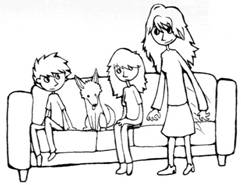German Reader 1.0
 | German Readers 1.0 is $11 per copy. |
| You can select the quantity of books you want in the next screen after you press "Add to Cart". Shipping will be calculated after you input your address during the checkout process. If you would like to purchase other books you can just return to the site and add them to your cart, then check out all at once. |
|
Description
The German Reader 1.0 is a beginning reader containing 44 short stories. To read the first story the student only needs to know the seven target words for that story. Words and phrases that have not been learned yet are in bold type. At the end of the story the words in bold type are listed along with their English meanings.
To read the second story the student only needs to know the new target words and phrases and those from story #1. Again, any words the student has not yet learned are in bold type, listed at the end of the short story along with the English meanings.
This pattern repeats itself throughout the 44 short stories. The 1.0 Reader vocabulary and level of difficulty at the end of the reader meshes seamlessly with the next reader in the series, the 1.1 Reader.
The German Reader 1.0 was piloted by three high school teachers with their beginning students, with positive feedback.
The target vocabulary closely mirrors the vocabulary of Michael Miller’s SABINE UND MICHAEL, Level 1, chapters 1 and 2.
The reader is 5.5 inches x 8.5 inches and 152 pages. Average story length is 260 words.
ISBN 13: 978-0-9816079-4-8
To place an order please visit the Bookstore.
Audio download
An audio download of all German Reader 1.0 stories being read slowly is available for purchase in the Book Store. Each slow reading in German is followed by the English translation. The reading of each story includes the reading of the questions found at the end of each story. Total recording time, including the reading and translation of stories which are in both present tense and conversational past tense, is about six and a half hours.
To place an order please visit the Book Store.
Teacher’s Manual
There is also a Teacher’s Manual available for this German Reader. More information is here.
To place an order please visit the Bookstore.
Classroom use
Here are four ways to use this reader:
Supplemental reading
The reader can be used for supplemental reading.
Support for SABINE UND MICHAEL, Level 1
The target vocabulary closely mirrors the vocabulary of Michael Miller’s SABINE UND MICHAEL, Level 1 chapters 3 and 4. Teachers can have their students read the stories in support of their SABINE UND MICHAEL-based lessons.
TPRS lessons
In my classroom, I use the TPRS method of language teaching. I teach the target vocabulary sequentially from story 1 to story 44. After the students have learned each new set of target vocabulary words/phrases in TPRS-based lessons, the students read the corresponding story.
Supplemental reading for students learning German on their own
Because the vocabulary builds upon itself and the stories offer ample repetition, the 1.0 Reader is an excellent resource for beginning students of German. Since each reader meshes seamlessly into the next in the series, the self-learner has reading material for the equivalent of four years of high school German.
Excerpts
Below are stories 1, 5, and 30. The vocabulary and level of difficulty slowly increase throughout this beginning reader.
Geschichte 1
Target words and phrases
| der Junge | = | the boy | |||
| der Mann | = | the man | |||
| das Mädchen | = | the girl | |||
| die Frau | = | the woman | |||
| der Hund | = | the dog | |||
| steht…auf | = | stands up | aufstehen | = | to stand up |
| setzt sich | = | sits (action of sitting) | sich setzen | = | to sit |
Steht auf und setzt sich
(Stands up and sits)

Der Mann steht auf.
Der Mann setzt sich auf den Stuhl. |
|
||
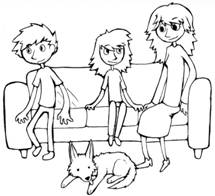
Der Junge steht auf.
|
|||
| Der Junge setzt sich auf das Sofa. Das Mädchen steht auf. Das Mädchen setzt sich auf das Sofa. Die Frau steht auf. Die Frau setzt sich auf das Sofa. Der Hund ist auf dem Fußboden. Der Hund steht auf. Der Hund setzt sich auf das Sofa. | |||
|
|||
| Die Frau hebt den Hund auf. Die Frau stellt (puts) den Hund auf den Fußboden. Die Frau setzt sich auf das Sofa. | |||
English meaning of words in bold type
| auf den Stuhl | = | on the chair |
| auf das Sofa | = | on the sofa |
| das Mädchen | = | the girl |
| ist auf dem Fußboden | = | is on the floor |
| hebt den Hund auf | = | picks up the dog |
| auf den Fußboden | = | is on the floor |
Geschichte 5
Target words and phrases
| fasst…an | = | touches | anfassen | = | to touch |
| der Hase | = | the rabbit | die Hasen | = | the rabbits |
| langsam | = | slow, slowly | |||
| schnell | = | fast, quickly |
Der Hund, das Mädchen und der Hase
(The dog, the girl, and the rabbit)
| Der Hase schaut den Hund an. Der Hund steht auf und schaut den Hasen an. Der Hund knurrt (snarls). | |
| Der Hund geht schnell zum Hasen. |  |
| Der Hase geht schnell zum Schreibtisch. Der Hase springt auf den Schreibtisch. Der Hase setzt sich auf den Schreibtisch. Der Hund geht schnell zum Schreibtisch und springt auf den Schreibtisch. | |
| Der Hase schaut den Hund an und der Hund schaut den Hasen an. Der Hund knurrt (snarls). | 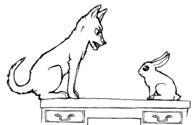 |
| Der Hund fasst den Hasen an. Der Hase beißt den Hund. Der Hund weint (cries). | |
| Der Hund geht schnell zum Mädchen. Der Hund fasst das Mädchen an. Der Hund zeigt auf den Hasen. Der Hund hat Angst vor dem Hasen. | 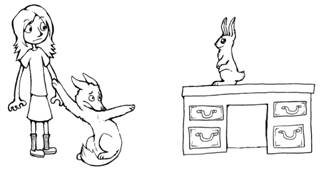 |
| Der Hase schaut das Mädchen an. Der Hase schaut den Hund an. Der Hase geht langsam zum Mädchen und zum Hund. Der Hund springt auf das Mädchen. Das Mädchen hält (holds) den Hund. Der Hund zeigt auf den Hasen. | |
| Der Hase schaut das Mädchen an. Der Hase schaut den Hund an. Das Mädchen schaut den Hasen an. Der Hase fasst das Mädchen an. Das Mädchen geht schnell zum Stuhl und springt auf den Stuhl mit (with) dem Hund. Das Mädchen schreit (screams). Der Hase schaut das Mädchen an und lacht (laughs). | |
English meaning of words in bold type
| beißt | = | bites | beißen | = | to bite |
| hat Angst vor dem Hasen | = | is afraid of the rabbit |
Beantworte die folgenden Fragen (Answer the following questions)
- Wer (who) schaut den Hund an?
- Wer zeigt auf den Hasen?
- Wer fasst das Mädchen an?
- Wer springt auf das Mädchen?
- Wer geht schnell zum Stuhl?
- Wer geht langsam zum Mädchen?
Geschichte 30
Target words and phrases
| Wie geht es Ihnen? | = | How are you? (formal) |
| Es geht mir gut. | = | I’m doing well/fine. |
| Es geht mir gut, danke. Und Ihnen? | = | I’m doing well thank you, and you? |
| auf | = | on |
| zwischen | = | between |
Wie geht es Ihnen?
(How are you?)
| Ein grüner Frosch und eine schwarze Fliege sind im Gras. Der Frosch sieht die Fliege und springt zur Fliege. Der Frosch ist hungrig. Der Frosch sagt: „Hallo, Fliege.“ | |
| Die Fliege sagt: „Guten Tag.“ | |
| Der Frosch fragt: „Wie geht es Ihnen?“ | |
| Die Fliege sagt: „Es geht mir gut, danke. Und Ihnen?“ | |
| Der Frosch sagt: „Es geht mir gut, aber es geht Ihnen nicht gut.“ Der Frosch frisst die Fliege. Der Frosch sagt: „Danke“, und rülpst (burps). „Es geht mir noch (even) besser.“ Der Frosch lacht und springt herum (around). Er springt auf dem grünen Gras. Er springt zwischen zwei Büschen. Er springt zwischen zwei Blumen. Er springt zwischen zwei Hasen. Er springt auf einen Gartenstuhl. | |
| Ein Vogel sitzt auf dem Gartenstuhl. Der Vogel sieht den Frosch. Der Vogel ist hungrig. Der Vogel fragt den Frosch: “Wie geht es Ihnen?“ | |
| Der Frosch sagt: „Es geht mir gut.“ Der Frosch fragt den Vogel: „Wie geht es Ihnen?“ | |
| Der Vogel sagt: „Es geht mir sehr (very) gut, aber es geht Ihnen schlecht.“ Der Vogel frisst den Frosch. Der Vogel singt. Der Vogel fliegt zu seinem Nest und rülpst (burps). Das Nest ist in einem Baum. | |
| Eine Katze sieht den Vogel. Die Katze ist hungrig. Die Katze fragt den Vogel: „Wie geht es Ihnen, Herr Vogel?“ | |
| Der Vogel sagt: „Es geht mir gut.“ Und der Vogel singt: „ ♪ ♫ ♪ ♫ ♪“. Der Vogel fragt die Katze: „Wie geht es Ihnen, Frau Katze?“ | |
Die Katze sagt: „Es geht mir gut, aber es geht Ihnen nicht gut. Es geht Ihnen schlecht.“ 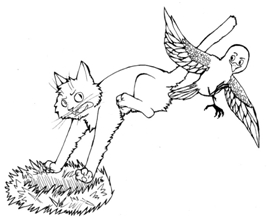 Die Katze springt auf das Nest des Vogels. Der Vogel fliegt schnell weg. Die Katze sitzt auf dem Nest und runzelt die Stirn. Der Vogel fliegt herum (around) und singt und lacht. Der Vogel fliegt zwischen zwei Bäumen. Der Vogel fliegt zwischen zwei Hasen. Die Katze springt auf das Nest des Vogels. Der Vogel fliegt schnell weg. Die Katze sitzt auf dem Nest und runzelt die Stirn. Der Vogel fliegt herum (around) und singt und lacht. Der Vogel fliegt zwischen zwei Bäumen. Der Vogel fliegt zwischen zwei Hasen. |
|
| Der Vogel singt: „Es geht mir gut. Es geht mir wunderbar (wonderful), ♪ ♫ ♪ ♫.“ Dann (then) hat der Vogel eine Idee. Der Vogel fliegt zur Katze und pickt die Katze auf den Kopf. | |
| Die Katze sagt: „Autsch.“ Es geht der Katze schlecht. Der Vogel fliegt herum und singt: „ ♪ ♫ ♪ ♫“ und sagt: „Es geht mir noch (even) besser.“ |
English meaning of words in bold type
| die Fliege | = | the fly | ||||
| sind | = | are | ||||
| hungrig | = | hungry | ||||
| Note the „-ig“ at the end of ,,hungrig“ | ||||||
| is pronounced „ich“ [Austrians say „ik.“] | ||||||
| es geht Ihnen nicht gut | = | you are not doing well | ||||
| die Büsche | = | the bushes | der Busch | = | the bush | |
| die Blumen | = | the flowers | die Blume | = | the flower | |
| der Gartenstuhl | = | the garden chair | ||||
| der Vogel | = | the bird | ||||
| Es geht Ihnen schlecht. | = | It’s going bad for you. | ||||
| singt | = | sings | singen | = | to sing | |
| fliegt | = | flies | fliegen | = | to fly | |
| der Baum | = | the tree | ||||
| Herr | = | Mr. | ||||
| Frau | = | Ms./Mrs | ||||
| auf das Nest des Vogels | = | on the bird’s nest | ||||
| weg | = | away | ||||
| lacht | = | laughs | lachen | = | to laugh | |
| zwischen zwei Bäumen | = | between two trees | ||||
| die Idee | = | the idea | ||||
| pickt | = | pecks | picken | = | to peck | |
Beantworte die folgenden Fragen (Answer the following questions)
- Wer ist hungrig?
- Wer frisst die Fliege?
- Wo ist das Nest?
- Singt der Frosch? (Does…?)
- Fängt die Katze den Vogel?
Note: Starting with story # 4, each story is followed by a series of questions for the students to answer as homework or in class conversation.

